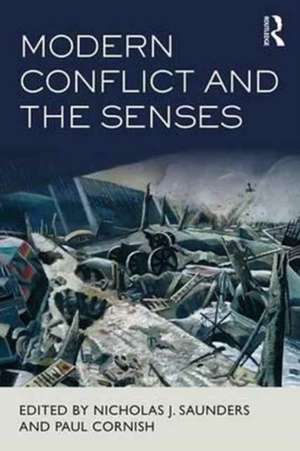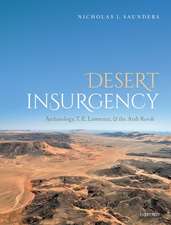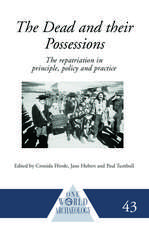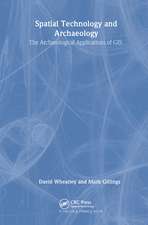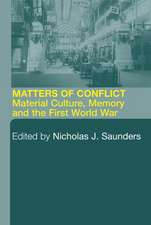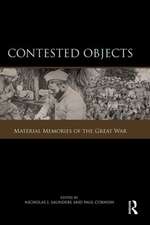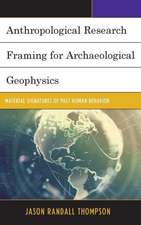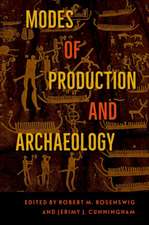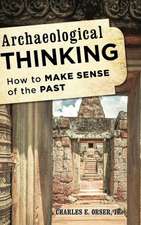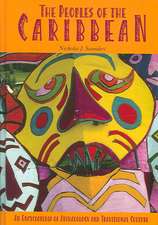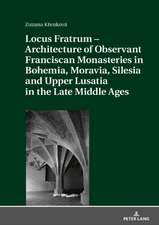Modern Conflict and the Senses
Editat de Nicholas J. Saunders, Paul Cornishen Limba Engleză Hardback – 16 mar 2017
| Toate formatele și edițiile | Preț | Express |
|---|---|---|
| Paperback (1) | 389.66 lei 6-8 săpt. | |
| Taylor & Francis – 12 dec 2019 | 389.66 lei 6-8 săpt. | |
| Hardback (1) | 828.48 lei 6-8 săpt. | |
| Taylor & Francis – 16 mar 2017 | 828.48 lei 6-8 săpt. |
Preț: 828.48 lei
Preț vechi: 1107.79 lei
-25% Nou
Puncte Express: 1243
Preț estimativ în valută:
158.55€ • 165.32$ • 131.77£
158.55€ • 165.32$ • 131.77£
Carte tipărită la comandă
Livrare economică 21 martie-04 aprilie
Preluare comenzi: 021 569.72.76
Specificații
ISBN-13: 9781138927827
ISBN-10: 1138927821
Pagini: 416
Ilustrații: 79
Dimensiuni: 156 x 234 x 25 mm
Greutate: 0.93 kg
Ediția:1
Editura: Taylor & Francis
Colecția Routledge
Locul publicării:Oxford, United Kingdom
ISBN-10: 1138927821
Pagini: 416
Ilustrații: 79
Dimensiuni: 156 x 234 x 25 mm
Greutate: 0.93 kg
Ediția:1
Editura: Taylor & Francis
Colecția Routledge
Locul publicării:Oxford, United Kingdom
Public țintă
PostgraduateCuprins
Foreword: David Howes.
Introduction: Paul Cornish, Nicholas J Saunders, Mark Smith
Part 1: Sensual Landscapes
1: Sensing War: Concept and Space in the Imperial War Museum’s First World War Galleries. Paul Cornish.
2: Materiality, Space, and Distance in the First World War. Nicholas J. Saunders.
3: Assaulting the Senses: Life and Landscape beneath the Western Front. Matthew Leonard.
4: The scent of snow at Punta Linke: First World War sites as sensecapes, Trentino, Italy’. Franco Nicolis.
5: Sensorial engagement in tourism experiences on the Western Front. Stephen Miles.
6: ‘Dead Air’: The acoustic of war and peace – creative interpretations of the sounds of conflict and remembrance. Paul Gough and Katie Davies.
7: Moaning Minnie and the Doodlebugs: Soundscapes of Air Warfare in
Second World War Britain. Gabriel Moshenska.
8: ‘The Cave Mouth: Listening to sound and voice in Okinawan war
memory. Rupert Cox and Angus Carlyle.
9: Emplacing the Italian Resistance: the dystopian fight against Fascism
and Nazism (1943-1945). Sarah De Nardi.
Part 2: Sensing Bodies
10: Odour and Ethnicity: Americans and Japanese in the Second World War. Susannah Callow.
11: Ingestion and Digestion on the Western Front. Rachel Duffett.
12: Trench Crap: Excremental aspects of the First World War. Dominiek Dendooven.
13: Sense and Sensibility: the power of print in post-war recuperation. Jeffrey S. Reznick.
14: The ‘White Death’: Thirst and Water in the Chaco War. Esther Breithoff.
15: Jan Karski: From Eye Witness to Moral Witness. What to do with your senses. Annette Becker.
16: The Sensory Signature of being an airman in a Second World War Lancaster Bomber. Melanie Winterton.
17: Sounds of Horror: Sensorial experiences of a Gestapo prison, Begunje (Slovenia). Uroš Košir.
18: The uninvited guests who outstayed their welcome: the ghosts of war in the Channel Islands. Gilly Carr.
19: Sensory deprivation during the Irish Civil War (1923-1924): Female political prisoners at Kilmainhan Gaol, Dublin. Laura McAtackney.
Part 3: Sensorial Objects
20: Sensing the Sepoy: Objects, letters and songs of Indian Soldiers, 1914-1918. Santanu Das.
21: War with Flowers: The paintings of Albert Heim and the German sensory experience of the Somme, 1914-1916. Alastair H. Fraser.
22: The Senses: Battlefield exploration, drawing and sculpture. Steve Hurst.
23: War, memory and the senses in the Imperial War Museum London, 1920-2014. Alys Cundy.
Afterword: Joanna Bourke.
Introduction: Paul Cornish, Nicholas J Saunders, Mark Smith
Part 1: Sensual Landscapes
1: Sensing War: Concept and Space in the Imperial War Museum’s First World War Galleries. Paul Cornish.
2: Materiality, Space, and Distance in the First World War. Nicholas J. Saunders.
3: Assaulting the Senses: Life and Landscape beneath the Western Front. Matthew Leonard.
4: The scent of snow at Punta Linke: First World War sites as sensecapes, Trentino, Italy’. Franco Nicolis.
5: Sensorial engagement in tourism experiences on the Western Front. Stephen Miles.
6: ‘Dead Air’: The acoustic of war and peace – creative interpretations of the sounds of conflict and remembrance. Paul Gough and Katie Davies.
7: Moaning Minnie and the Doodlebugs: Soundscapes of Air Warfare in
Second World War Britain. Gabriel Moshenska.
8: ‘The Cave Mouth: Listening to sound and voice in Okinawan war
memory. Rupert Cox and Angus Carlyle.
9: Emplacing the Italian Resistance: the dystopian fight against Fascism
and Nazism (1943-1945). Sarah De Nardi.
Part 2: Sensing Bodies
10: Odour and Ethnicity: Americans and Japanese in the Second World War. Susannah Callow.
11: Ingestion and Digestion on the Western Front. Rachel Duffett.
12: Trench Crap: Excremental aspects of the First World War. Dominiek Dendooven.
13: Sense and Sensibility: the power of print in post-war recuperation. Jeffrey S. Reznick.
14: The ‘White Death’: Thirst and Water in the Chaco War. Esther Breithoff.
15: Jan Karski: From Eye Witness to Moral Witness. What to do with your senses. Annette Becker.
16: The Sensory Signature of being an airman in a Second World War Lancaster Bomber. Melanie Winterton.
17: Sounds of Horror: Sensorial experiences of a Gestapo prison, Begunje (Slovenia). Uroš Košir.
18: The uninvited guests who outstayed their welcome: the ghosts of war in the Channel Islands. Gilly Carr.
19: Sensory deprivation during the Irish Civil War (1923-1924): Female political prisoners at Kilmainhan Gaol, Dublin. Laura McAtackney.
Part 3: Sensorial Objects
20: Sensing the Sepoy: Objects, letters and songs of Indian Soldiers, 1914-1918. Santanu Das.
21: War with Flowers: The paintings of Albert Heim and the German sensory experience of the Somme, 1914-1916. Alastair H. Fraser.
22: The Senses: Battlefield exploration, drawing and sculpture. Steve Hurst.
23: War, memory and the senses in the Imperial War Museum London, 1920-2014. Alys Cundy.
Afterword: Joanna Bourke.
Notă biografică
Nicholas J. Saunders is Professor of Material Culture at Bristol University and co-director of two long-term First World War projects: the ‘Great Arab Revolt Archaeological Project’ (Jordan), and the ‘Isonzo Valley Conflict Landscapes Project’ (Slovenia/Italy). He has published numerous articles and books on the archaeology and anthropology of modern conflict, including Trench Art: Materialities and Memories of War (2003), Matters of Conflict (2004), Killing Time: Archaeology and the First World War (2007), and co-edited with Paul Cornish Contested Objects (2009) and Bodies in Conflict (2014).
Paul Cornish is Senior Curator at the Imperial War Museum, and played a leading role in the museum’s Regeneration Project for the 2014 Centenary. He has co-organised five IWM-based international and multidisciplinary conferences on modern conflict, has published Machine Guns and the Great War (2009) and The First World War Galleries (2014), and co-edited Contested Objects (2009) and Bodies in Conflict (2014).
Paul Cornish is Senior Curator at the Imperial War Museum, and played a leading role in the museum’s Regeneration Project for the 2014 Centenary. He has co-organised five IWM-based international and multidisciplinary conferences on modern conflict, has published Machine Guns and the Great War (2009) and The First World War Galleries (2014), and co-edited Contested Objects (2009) and Bodies in Conflict (2014).
Descriere
Modern Conflict and the Senses investigates the sensual worlds created by modern war, focusing on the sensorial responses embodied in and provoked by the materiality of conflict and its aftermath. The volume positions the industrialized nature of twentieth-century war as a unique cultural phenomenon that embodies the extremes of human behaviour, from total economic mobilization to the unbearable sadness of individual loss. Adopting a coherent and integrated hybrid approach to the complexities of modern conflict, the book considers issues of memory, identity, and emotion through wartime experiences of tangible sensations and bodily requirements.
